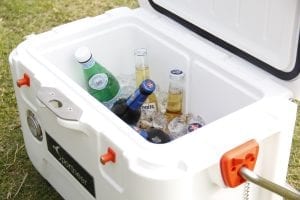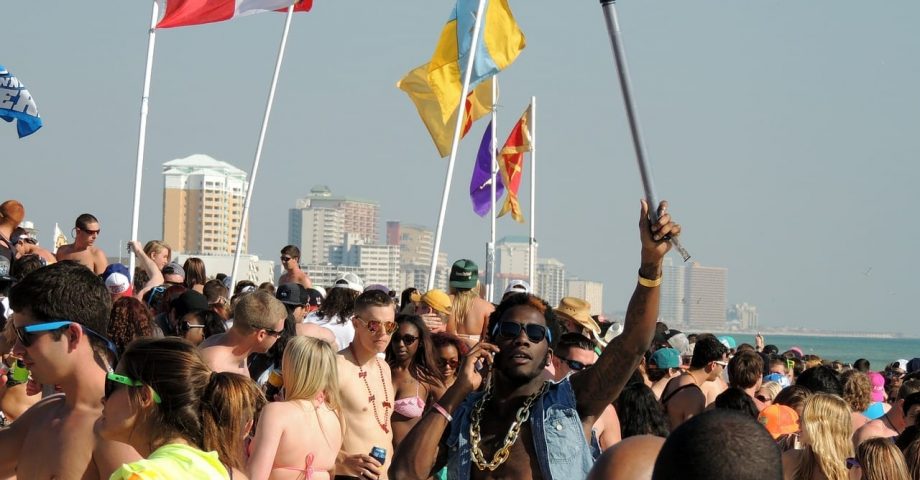Spring Break is a crazy period in the US calendar where college students break free from studies for a couple of weeks to let loose. Originally starting as a swimming event back in the 1930s, it has since evolved into a celebration that has a number of shocking statistics attached to it. While it is always good to break free and let your hair down, Spring Break has become associated with debauchery and drug or alcohol abuse in recent years.
However, the two-week period remains extremely lucrative, with an extraordinary amount of money being spent by US students in their home country alone. Spring Break may be a lot of fun for millions of students – but it’s just as important to stay safe, particularly as some of the stats we’ve pulled together are actually pretty shocking. Let’s take a look these fun facts about Spring Break!
1. Spring Break used to be a school tradition.
Spring Break is traditionally a period between term times when schools and universities take holidays.
It was a term coined initially for the US school calendar, but it’s since been adopted elsewhere across the world.
Interestingly, the term actually started in 1938, when a swimming coach decided to take his team for early training in Fort Lauderdale. However, by the 60s, students from across the nation had already started using that time period to go on holiday together.
2. Spring Break is big money for the American economy.
Spring Break is said to generate more than $1 billion a year for the US economy. Put it this way, over 1.5 million US college students travel around Spring Break.
And, on average, each student spends over $1,000! It’s no wonder it’s such a big money-maker!
3. Spring Breaks have been a part of the culture since the 60s.
As mentioned above, the tradition of taking Spring Breaks started in the US in the 1930s. However, by 1960, the concept was actually established in school calendars! Spring Break is usually spread out over two weeks, offering a good break from studying and finals for the students.
Typically, US students celebrate Spring Break between the second week of March and the start of April, though this can vary from school to school. Check your local details!

4. Emergency services always need to be on standby.
In some countries, police departments and hospitals make advance preparations to cover the inevitable heavier demand for attention during Spring Break.
For example, in 2023, in Panama City, all local law enforcement agencies partnered up to join forces during Spring Break!
American students often travel abroad to areas such as Mexico and parts of the Caribbean for Spring Break – meaning local services and authorities need to beef up their support during this period.
5. Spring Break can result in mayhem for public services.
In recent years, over in Panama City, where 500,000 students and pupils are known to travel for Spring Break, around 60% were confronted by police for misdemeanours or ‘guidance’.
In many places, the figures for alcohol abuse, drunk and disorderly arrests, drug abuse, and minor accidents rise in line with Spring Breaks and other university/school holidays.
For example, it’s thought that South Padre Island, a popular Spring Break destination, oversees around 25 arrests every day during the period.
6. Panama City protects itself against “Spring Break Mania.”
Panama City decided to ban alcohol from its beaches in March following a series of alcohol-induced problems. The rule was put in place in 2015.
That being said, other rules were also put in place specifically for the Spring Breakers. For example, in Panama City, it is legal to sell alcohol after 2 am during the period between March 1st and March 31st. That being said, that rule only applies to that specific area and nowhere outside of it – but, unsurprisingly, other areas are likely to follow suit.
7. Spring Break is an alcoholic rite of passage.
Spring Break is often seen as a rite of passage for many teenagers, though it can stereotypically lead to antisocial behavior. It’s thought that men on Spring Break will drink around 18 alcoholic beverages a day, while women will drink around 10.
Tragically, Spring Break and the peer pressure that comes with it often not only leads to the mass overconsumption of alcohol but also underage drinking and even underage binge drinking. This kind of approach to alcohol can easily lead to emergencies and even fatalities – hence the need for extra emergency services!
8. Spring Break technically dates back centuries.
Historically, the Romans and Greeks held celebratory gatherings in Spring. They drank to ‘new beginnings’ and the Gods Dionysus and Bacchus. The festive period was known as “Anthesteria.”
The festivities could last for several days. Some historians note that these were really the first Spring Breaks. Some traditions included women covering themselves with flowers and men competing to see who could drink the most wine and who could drink it the fastest!
The latter of these is still very much a common and dangerous alcoholic game today – some things, for better or worse, really don’t change.
9. There’s an area rebuilt for Spring Breakers.
Cancun, a popular city and resort in Mexico, is literally built for Spring Break – it was devastated by storms and was rebuilt to encourage Spring Break visitors after the late 80s. As such, it’s now one of the most-favored Spring Break locations for US teens. The area is known for its lively nightlife, many specialized clubs, and for being relatively affordable for most budgets, not to mention the fantastic weather in the Spring! It’s no wonder it’s such a popular destination among Spring Breakers!

10. Modern Spring Break traditions date back to the 1930s.
In the 1930s, Fort Lauderdale in the US became the favored destination for Spring Breakers keen on swimming. Those from Colgate College began what was to become a regular feature on the calendar, as they were joined by students from other cities as part of the holiday ritual.
While the area is still known for being a popular tourist destination, especially during Spring Break, Fort Lauderdale has since become a key destination for a more mature audience.
Beyond that, as mentioned, US students travel overseas to enjoy their two weeks off – Mexico being a particular hotspot.
11. Spring Break was popularised through film.
In 1960, MGM released a film based on the book “Where The Boys Are” about Spring Break activities. The author was a Michigan University Professor, Glen Swarthout.
The book and subsequent film were so successful and gave such good publicity to Fort Lauderdale that it quickly became the heart of Spring Break across the US.
What’s more, TIME Magazine played a part in popularizing the culture in an issue dated April 1959. “Beer and The Beach” was the headline. Pretty fitting!
12. Spring Break travel destinations vary wildly.
In 2015, the Chicago Tribune stated that over 50% of the student population planned to travel widely to visit holiday destinations during Spring Break. Notably, Miami, Cancun and San Juan had been listed as favored destinations.
Today, while places such as Florida and Mexico are still very popular among Spring Breakers, it appears as though European cities are becoming the place to be for these traveling college students. Look out, Europe!

13. Spring Breakers sometimes don’t play fair.
South Padre has reported huge swathes of Spring Break arrests over the years. It’s thought to average around 25 per day during the visitation period.
In Miami Beach, in 2024, around 270 people were arrested during Spring Break! The mania around this fabled two-week period isn’t slowing down.
14. Spring Break bestows local nicknames.
Fort Lauderdale has earned itself the rather dubious nickname of ‘Fort Liquordale’ amongst Spring Breakers.
That being said, some locals are embracing the nickname, especially a wine and spirit shop of the exact same name in the area!
15. There are alternatives to Spring Break.
In 2006, a new program started in the US to promote an alternative to partying during Spring Break. The Nationwide scheme, “United Way,” involved students choosing to work in local neighborhoods and providing positive aid to communities.
And, while it may not be quite as fun as a traditional Spring Break, it does help the students with networking, work experience, and even boosting their resumes for post-graduation.

16. Spring Break causes fatalities.
Spring Break can be dangerous – small numbers of people fall from hotel balconies to their deaths as a result of misadventure.
In 2023, there were even two fatal shootings in Miami Beach during Spring Break.
17. Spring Break extends beyond the US.
Problems during Spring Break don’t just occur in the US. More than 2,500 US tourists are thought to have been arrested outside America during their travels.
However, in some countries, the Spring Break culture simply doesn’t exist! In the UK, for example, there are “half term” and Easter holidays – but many British people claim the weather simply isn’t predictable or warm enough there to risk mass road trips! It’s not unheard of for British teenagers to seek out the true Spring Break experience in North America, however.
18. Spring Break is great for tourism.
Spring Break fast became a major tourism industry driver. For example, the College Tours and Student Tours company started offering inclusive packages to help students explore popular locations during the period.
Cancun’s popularity as a Spring Break destination is said to have grown largely thanks to the drinking age being below 21. This would – naturally – mean many students across the US could legally partake in alcohol!

19. Millions take part in Spring Break.
It’s thought that around 2.1 million students took part in Spring Break events in 2010, and this has likely only grown since then.
However, as a result of the COVID-19 pandemic in 2020, Spring Break was effectively curtailed to help stem the spread of the virus. This is said to have had a huge knock-on effect on many tourism businesses.
20. Spring Break travel is trending downward.
Remember the stats we shared earlier about Spring Break and travel plans? Well, fewer and fewer people are traveling during this period in a post-COVID world.
In 2024, only around 55% of adults in the US claimed they would be traveling during the Spring, which is a massive decrease from 65% in 2023.
There are many reasons why this could be the case. For example, the economy and rising inflation are forcing many young people and families to reconsider where and when they vacation.
21. Many people are “against” Spring Break.
The American Medical Association has warned the US about the potential dangers of Spring Break escapades. Specifically, they stated ‘Spring Break is no longer an innocent respite from the rigors of college academics – it’s potentially life-threatening.”
Miami Beach, in fact, has actively tried to deter people from heading to the area during Spring Break despite the financial benefits! In 2024, the locality shared online ads trying to deter visitors by stating the parking was too expensive. This backfired somewhat, as many TikTok users became more aware of the destination as a result!

22. Booze is a problem across the period.
Around half of male students interviewed in one poll stated they drank alcohol until they were either sick or passed out. The figure is slightly less for women at 40%.
23. Safety is always an issue on Spring Break.
Around 50% of sexual encounters during Spring Break reportedly go unprotected.
It’s thought around 60% of students on Spring Break will suffer an injury of some kind, self-inflicted or otherwise.
In fact, if you’re planning to travel for Spring Break, be sure to consult a safety and preparation guide before you go. The University of Michigan has a fantastic list to help you stock up on essentials and set timetables for your vacation.
24. Spring Break isn’t necessarily reflective of US teenagers’ behavior.
Outside of Spring Break, it’s recorded that 80% of students in the US will engage in sexual activity once or less per year, and most college students only consume around six alcoholic beverages a week.
These stats clearly show that Spring Break is a period when many young people choose to cut loose – and it’s become a part of the culture over the decades.

25. It’s not for the faint of heart.
As mentioned above, a big part of Spring Break is peer pressure. Many students have reported that they have drunk so much, tried certain substances, and even been more sexually promiscuous than they would usually be in order to “fit in.” However, it’s that kind of worry and pressure that leads to huge mistakes and fatalities.
26. Spring Break is a big part of Western popular culture.
The concept of Spring Break is often found in famous Hollywood films. Obviously, the film Spring Breakers shows a certain side of the festivities, while other films such as She’s All That, 22 Jump Street, and Dirty Grandpa show the more traditional (albeit absurd) side of Spring Break.
Even films for children mention and feature Spring Break, Scooby-Doo being a prime example of it! However, if anything, the film probably deters kids away from Spring Break!
It has also featured in TV shows such as Gilmore Girls and Friends – meaning knowledge of the culture has really exploded overseas, too.
27. There are multiple festivals during Spring Break.
Taking advantage of mass tourism, there are many festivals held throughout Spring Break in the US and even other countries!
Some of the most popular Spring Break festivals include Tortuga Music Festival, UTOPiAfest, and Boots in the Park.

28. There are some golden rules to follow if you’re going on Spring Break.
No one can stop you from wanting to go on Spring Break, but it is important to remain safe. Alongside the University of Michigan’s fantastic guide linked above, we have a few easy tips that should help protect you.
It is always best to travel with people you know and trust. Going somewhere alone, especially during Spring Break, can be incredibly dangerous.
Remember to stay hydrated, too. Whether you are drinking a lot of alcohol or not, most Spring Break locations are incredibly warm, and it’s easy to become dehydrated.
Wearing sunscreen may seem obvious, but getting burned in some of the most popular Spring Break spots is very common. In fact, it is best to avoid the sun altogether during the hottest times of the day and for extended periods of time to avoid heatstroke.
Make sure your family knows where you are. Letting them know at least once a day that you are OK will prevent them from worrying, and could even be a life saver if you don’t let them know!
29. Spring Break offers tons of volunteering opportunities.
Many teenagers and young adults use Spring Break as a force for good, too! There are growing movements where young people help to clean up beaches after the festivities, rebuild communities, and try and give a little back.
It’s a move to try and dispel the idea that all young people just want to party during Spring Break. Could things be moving in the opposite direction from here, then?
FAQs about Spring Break
How old are spring breakers, on average?
Spring Break tends to be aimed at college freshmen and older - 18 years and up - though people still attend parties well into their mid 30s and even older! Many underage kids also try to attend Spring Break events – meaning organizers need to be extra vigilant!
When did MTV start covering Spring Break?
MTV’s iconic Spring Break coverage would start in 1986 - the first broadcasts took place in Daytona Beach, in Florida.
In fact, MTV's Spring Break has appeared in films such as She’s All That and TV shows such as Friends!
When does Spring Break fall?
That all depends on your college - answering ‘spring’ would be too easy, so make sure to check with your fraternity or sorority.
Do you know any fun facts about Spring Break? Share them in the comments below!









